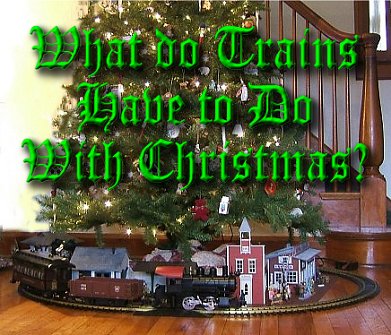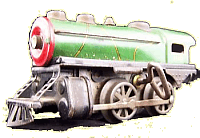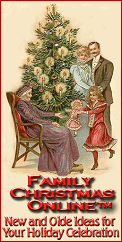 | |||
 |
 |  |
 |  |
 |  | ||
 |  | ||
 |  | ||
 | |||
 |
 |  |
 |  |
 |  | ||
 |  | ||
 |  | ||



|
What Do Trains Have To Do With Christmas?When I was growing up in the American midwest in the fifties and sixties, the train around the tree seemed every bit as important to our Christmas celebration as, say, Santa or Christmas stockings. As an adult, I realize that trains and Christmas have "gone together" for generations in most parts of the country. But it wasn't always so, and it some ways, it doesn't even make sense. It's not like Mary and Joseph rode a train from Nazareth to Bethlehem. Nor was Santa ever sighted delivering packages by Railway Express Agency. But to many families today, a toy or model train around the Christmas tree seems as "normal" as a star or angel on the top. As far as I can figure there are at least three reasons for this (in the United States and Canada, anyway - if anyone from other countries wants to contribute to this discussion, I will most gladly include your comments):

The Rise of Toy TrainsToy or model trains have been given at Christmas almost since there were trains. At first, these gifts were only toys by anyone' s definition. In the late-19th century, push-toys that looked like trains joined push-toys that looked like wagons or ponies underneath many Christmas trees. Wind-up toy trains weren't far behind. Still, there seemed to be no particular sense that it was more suitable to give a toy train for Christmas, than, say, for a birthday. Wind-up toy trains weren't far behind. Still, there seemed to be no particular sense that it was more suitable to give a toy train for Christmas, than, say, for a birthday.
In fact, the most impressive line of "push toy" trains was meant to be used during warm weather. Buddy L* trains were very large stamped-metal push-toy trains for which you could buy track. The First Powered Toy TrainsThe first working model trains were not necessarily "Christmas" trains, or even toys. They were steam-powered models that required a certain amount of skill and patience to operate safely. Sometimes these came into the home at Christmas, but, even if you had a circle of track for it, you wouldn't want to run a locomotive burning real fuel underneath a real cut tree.In 1901, Lionel showed New York City families that it was possible to fit an electric motor into a toy locomotive and power it by low-voltage electric current. A new industry and a new hobby were born. Really Big Trains Were the Rule at First The first electric trains were large by today's standards. Most of them were about the size of today's garden trains, although you couldn't use them outside, of course - they were tin-plated steel that would eventually rust under the driest conditions. The first electric trains were large by today's standards. Most of them were about the size of today's garden trains, although you couldn't use them outside, of course - they were tin-plated steel that would eventually rust under the driest conditions.
These "Standard Gauge" trains ran on track with the rails about 2" apart. Cars seven inches high, five inches wide, and 16" long were common, although some of the cheaper sets used smaller measurements. Of course, once the mysterious huge box was opened, it was only logical to route the train around the now-naked-looking Christmas tree.** So between Christmas and the day the tree came down, the train would run almost constantly, with almost everyone in the family taking a turn at operating it. Next year, of course, the train would come out before the presents appeared, and run a week or two before Christmas. And any cars or accessories in the new pile of presents were added to the temporary "railroad" as well. Christmas Railroads, Train Gardens, and "Putzes" ArriveBetween 1910 and 1960, it became common in some middle-class homes to build elaborate temporary railroads between Thanksgiving and Christmas. Many of these started as an extension of the Christmas tree route, but some took over spare rooms, back porches, and so on. In Roman Catholic homes, these often started with the Nativity set near or under the tree, then other buildings and accessories, were added, usually with no attention to scale or time period.In the Baltimore/DC area, these seasonal railroads were called "train gardens;" they had buildings, figures, many accessories, and maybe even multiple trains running at the same time. The train garden tradition became so strong that Baltimore/DC-area fire stations would leave their engines outside until after Christmas and set up large community train gardens in their parking bays. (Note: Several collectors/historians and I have been trying to collect photos of home and fire-house train gardens to post for our readers, with few results. If you have any, please contact us and we'll figure out how to reimburse you for the cost of copying and sending them or whatever - this is an important American Christmas tradition that is on the verge of being forgotten.) In other parts of the East, the seasonal household railroads and their associated "communities" were called "putzes," from the German word for "put," "set up," or "putter." All of these Christmas railroads and villages were important precursors of the Holiday Villages that were made popular by Dept. 56 many years later, as well as the display railroads operating in many botanical gardens as I write this article. (Even today, certain Maryland fire departments strive to keep the Train Garden tradition alive.***) Trains Became Smaller And More RealisticUnfortunately, Standard Gauge trains were too big to leave sitting out indefinitely. After a while, it wasn't enough to have a single huge train running around the Christmas tree once a year. Rather, hobbyists might own several trains and have a permanent railroad set up on a custom-built table somewhere year-round. For decades Lionel owned the "lion's share" of such railroads, with American Flyer coming in a distant second. But both brands were still large enough to look good around the tree.
Christmas Railroads Take a Back Seat to Model RailroadsHO allowed serious hobbyists to fit more railroading into a small, but permanent space. For a while, many families that had HO railroads in the basement still ran Lionel or American Flyer trains around the tree during the holidays. But HO trains (and smaller scales) weren't big enough to make much of an impression around a full-sized Christmas tree. So the generation who grew up with "just" HO stopped bothering to set up temporary living-room railroads at Christmas.In the 1960s, both Lionel and American Flyer fell on hard times. Model railroaders were buying HO trains, and fewer and fewer Christmas trees were surrounded by working trains of any scale. Other forms of so-called "family" entertainment also began taking huge chunks out of people's schedules, the biggest single example being television. Later, video games, youth sports, and home computers drew even more energy and interest away from any kind of toy or model trains. Eventually, model railroading of all kinds was beginning to "level off" as a hobby, and many wondered how to keep the next generation interested in the hobby. Christmas Trains Re-EmergeYet several things were already happening, on two different continents, that would bring Christmas trains back from near-extinction.
In other words, whether it's around the tree, around a miniature town, or around a public display railroad, the Christmas train looks like it's back to stay. Still, there may be one other reason, we are welcoming Christmas trains back into our homes. Today's Christmas Trains Take You On a Sentimental JourneyWhen I was growing up in the 1950s and 1960s, we enjoyed our model trains in part because they were powerful models of incredibly powerful behemoths that could still be seen operating once in a while. Today, many people seem rather to like seeing trains running around a Christmas tree because it brings back memories of a simpler time, or at least of one time of year when good things happened to you just because somebody loved you, and not because of anything you'd accomplished recently.Many model railroaders model the most modern trains they can get their hands on. But the most popular Christmas trains are old-fashioned. I suspect that that nostalgia for "simpler times" is part of the cause. Even the collectible villages that those trains serve are old-fashioned and quaint; in recent years some have reproduced scenes from Norman Rockwell paintings. Others have modeled Dickens' London, Andy Griffith's Mayberry, and It's a Wonderful Life's Bedford Falls. Were those times really simpler? Not for most people, if you think about it. But they seem simpler than our lives today, because for most of us, someone else had to pay the bills, fix the cars and appliances, and make all of the hard decisions. And for most of us, the best time of all of those deceptively simple times was Christmas. Is it any wonder we feel our spirits lift when we hang our favorite ornament, sing strange old songs, or rewatch that old Christmas special that seemed too cheezy for words when we were young? And when the scent of vanilla extract from the kitchen mixes with the scent of fir or pine in the living room, all bets are off. As odd as it seems, those of us who grew up with big trains around the tree are affected just as much by the scent of a Lionel or American Flyer transformer that has been left on a little too long, the repetitive thunks and clicks of an endlessly circling train, and the erratic beam that our train's headlight casts around the room when all the room lights are off and only the train and the tree are powered. You can have your "Chestnuts Roasting on an Open Fire." Give me the cheery thunder and repetitive motion of a big Christmas train with a circle of track sitting right on a hardwood floor. How do you connect with the best days of the best years of your childhood? For my part, I reconnect with some of my best and earliest memories of my mother by making cut-out sugar cookies with my own children. I reconnect with some of my best and earliest memories of my father by running trains. Dad's still around, though not in the best of health, but we lost our mother on September 15 of this year. Because we had to cancel a trip, I've saved up more vacation this year than I meant to, but I hope to spend at least part of our family time at home this Christmas making cookies and running trains. And I wouldn't be surprised if, thirty years from now, my children do the same thing. Finally . . . .Most of all, enjoy the time you have with your family in the coming weeks. If big Christmas trains are part of the memories you are forming for the next generation, then our hearts are with you in that as well. Have the most blessed holiday season possible, Paul Race *Buddy L went out of business many decades ago. About 2004, another company entirely manufactured some electric trains under the Buddy L brand name. Those cast-metal and plastic trains bore no resemblance to the stamped tinplate Buddy L products, and the company disappeared almost as soon as the trains got into the warehouses. If the "real" Buddy L trains ever resurface in their stamped-tinplate glory, I'll be the first to support them.
To read more, or to look at recommended Garden Railroading and Display Railroad products, you may click on the index pages below.
| 



|

|

|  |
 |
 |  |  |
Note: Big Indoor Trains(tm), Family Garden Trains(tm), Big Christmas Trains(tm), Big Train Store(tm), and Garden Train Store(tm) are trademarks of Breakthrough Communications(tm) (www.btcomm.com). All information, data, text, and illustrations on this web site are Copyright (c) 1999, 2000, 2001, 2002, 2003, 2004, 2005, 2006, 2007 by Paul D. Race.
Reuse or republication without prior written permission is specifically
forbidden.
Big Indoor Trains(tm) is a participant in the Amazon Services LLC Associates Program, an affiliate advertising program designed to provide a means for sites to earn advertising fees by advertising and linking to amazon.com.
For more information, please contact me
